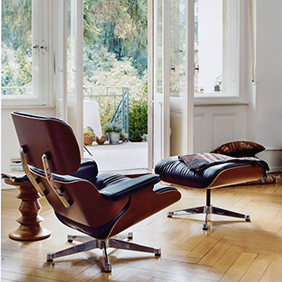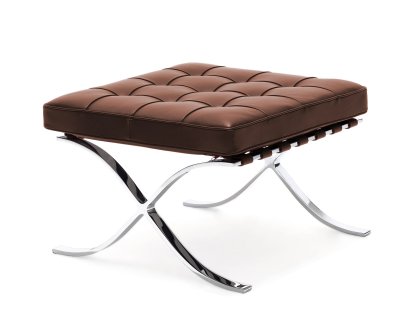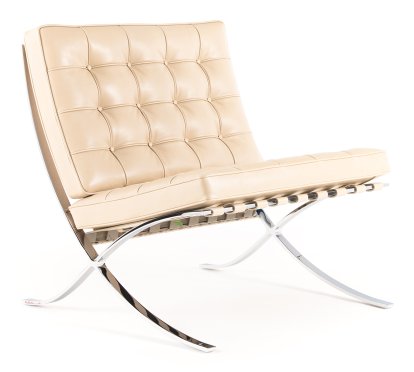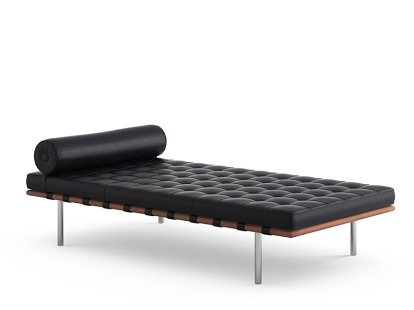Lilly Reich
First successes and her own business in Berlin
Lilly Reich, born in Berlin in 1885 as Marie Lilli Reich, is and was a pioneering modernist designer who has long been overshadowed by her male colleagues. Known for her work in the areas of interior design, furniture and exhibition design, she began her career with an apprenticeship in Kurbelstickerei, an embroidery technique in which the needle is turned by a crank located under the table. After completing her apprenticeship Reich began working in the Wiener Werkstätten in 1908 under the direction of the architect and designer Josef Hoffmann, returning to Berlin three years later where she founded her own studio for interior design, decorative art and fashion. Her first furniture and room furnishings quickly attracted attention: as early as 1912 she showed a model apartment for workers at an exhibition in the Berlin trade union building, which was particularly praised by the jury. In the same year, she became a member of the German Werkbund.
In 1914 Reich was represented at the Werkbund exhibition in Cologne and was able to present her design and furnishing ideas to a wider audience. However, the outbreak of the First World War forced her to change her work and switched to tailoring. In 1920 she was the first woman to be elected to the board of the German Werkbund.

Designer Lilly Reich
Collaboration with Mies van der Rohe and workshop management at the Bauhaus
Following her movie to Frankfurt in 1924 Lilly Reich met the architect Ludwig Mies van der Rohe, with whom she began a close collaboration and partnership from 1926 onwards. A collaboration led to numerous interior designs and exhibitions; one of the first and most important projects being the Werkbund exhibition “The Apartment”, a component of the 1927 Weissenhofsiedlung building exhibition in Stuttgart, where Reich was commissioned by Mies van der Rohe to plan and organize the exhibition, but also developed several interior designs, including the “Living Room in Mirrored Glass”.
In 1929 Reich took over the artistic direction of the German presentation at the World Exhibition in Barcelona, for which Mies van der Rohe designed the German pavilion and together they created the legendary Barcelona armchair and, a year later, the Barcelona lounger, which, like so many designs in which Lilly Reich was involved, were later attributed exclusively to Mies van der Rohe. Other examples are the Brno chair and the Krefeld sofa with its accompanying ottoman. These furniture designs were also created in connection with architectural projects and were later marketed only under van der Rohe's name.
One reason for this is that Lilly Reich and Mies van der Rohe worked very closely together from 1924 onwards and it was often not clear who designed what. The fact that the man was highlighted as the initiator and originator in this team is ultimately due to the patriarchal social structure of the time and to Mies van der Rohe personally. In addition, a large part of Lilly Reich's archive was destroyed in a bombing raid on Berlin in 1945, while Mies van der Rohe's archive was preserved, thanks in part to Lilly Reich's efforts, and is now largely in the MoMA in New York.
The 1927 Stuttgart exhibition was followed in 1931 by the German Building Exhibition in Berlin where Lilly Reich furnished two apartments in the boarding house, designed a ground floor house and designed the materials exhibition, before in 1932 Reich became head of the weaving workshop at the Bauhaus Dessau, a position she held until the Nazi Party took power in 1933.
Following Mies van der Rohe's enforced emigration to the USA Reich visited hi in Chicago in 1939, but returned to Germany, where Reich in the course of the War years she was temporarly drafted into Organisation Todt, the paramilitary construction force of the Nazi regime that was responsible for building projects in German-occupied areas, and also undertook private commissions, primarily in and around Berlin,
After the war Lilly Reich was heavily involved in the reconstruction of the German Werkbund, and took up a teaching position in interior design and building theory at the Academy of Fine Arts in Berlin, before her untimely death in Berlin in 1947.
Lilly Reich's contribution to modern design history, especially in her collaboration with Mies van der Rohe, is undisputed and is increasingly appreciated. Posthumously, and with great delay, she was the first woman to have a special exhibition dedicated to her at the MoMA in New York in 1996.

























